Perdigon nymphs were first developed by the Spanish fly-fishing anglers and then popularised by the French competition anglers for fishing their fast water streams. In this post, we’ll dive into my favourite patterns and the approaches to fish them, helping you maximize your success on the water.
What is a Perdigon Nymph?
Before we get into my most productive patterns, it’s important to understand what makes a Perdigon nymph unique. Named after the Spanish word for “pellet” or “bullet,” these nymphs are small, slim-bodied flies designed to sink quickly and cut through water with minimal resistance. This streamlined profile allows them to reach the strike zone swiftly, making them ideal for nymphing in fast water or deep pools.
Typically features of Perdigon Nymphs:
- Tungsten bead – Helps the fly sink quickly.
- Slim body – Made of thread or UV resin for minimal water resistance.
- Smooth, glossy finish – This slick surface helps the fly penetrate the water column efficiently.
- Short tails – Usually constructed from Coq de León or other stiff fibres, which mimic the tail of a real nymph but remain subtle.
- No hackle – Unlike many other nymphs, Perdigons avoid extra bulk like hackle or dubbing, which could slow the sink rate.
Now that we have a basic understanding of these nymphs, let’s dive into some of the best patterns for targeting trout and grayling.
Black Predigon Nymph
I’ll start with the black predigon nymph because it’s a great fly pattern for trout and grayling fishing on freestone rivers like the Welsh Dee, River Ribble and River Eden. Also, it’s simple to tie and has been…
the downfall of countless trout and grayling.
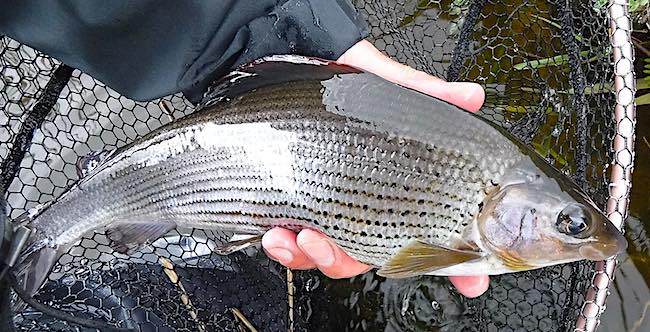
Material list
- Hook: HENDS BL 354 (Size 14 to 18)
- Bead: 1.5mm–3.5mm tungsten bead (silver, gold, copper)
- Thread: Black 8/0
- Tail: Coq de León fibers
- Body: Black thread or floss with UV resin.
- Rib: Silver wire
Step-by-step fly-tying instructions:
Don’t overdress the nymph because one with a slim body profile is more effective at catching trout and grayling. Also, if you’re new to fly tying, it’s an easy nymph to tie because the materials needed are cheap and easily obtained.
These nymphs can be tied on grub hooks, jig hooks or small fine wet hooks the smaller the better I generally tie them from size 18 to size 14.
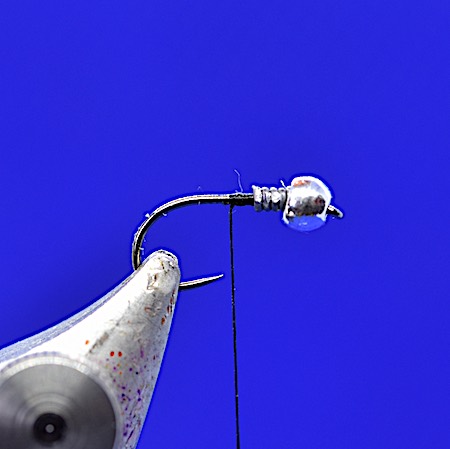
Step 1. Thread a 3 mm slotted tungsten bead onto a #14 FASNA F-400 hook. Add 4 turns of lead wire and push into the bead recess. Secure with waxed black tying thread.

Step 2. Tie in 3 – 4 Coq De Leon fibres with the tying thread and towards the hook. Stopping where the barb would be.
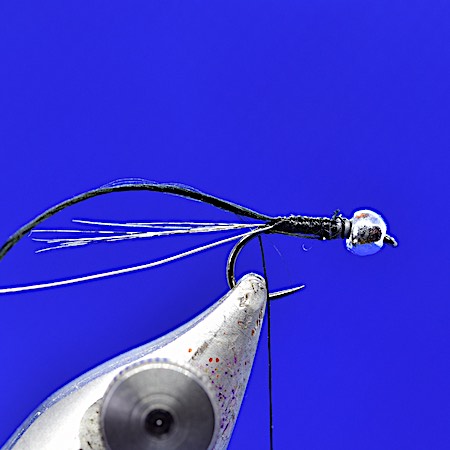
Step 3. Tie in a length of fine silver wire. Then tie in a short length of black floss.
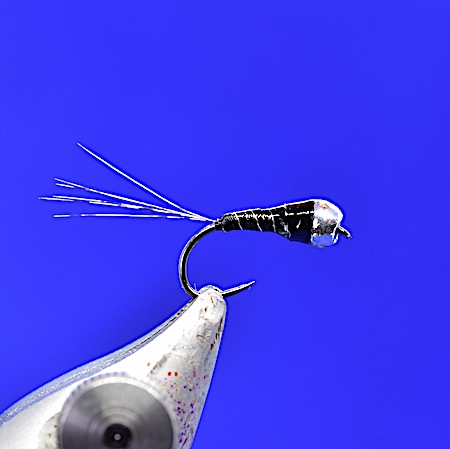
Step 4. Form a tapered body with the floss and then rib the body with the fine silver wire. Finally, coat the body with UV resin and cure.
This pattern excels in low-light conditions, or when fish seem to be unresponsive to more natural-colored nymphs. It’s particularly useful in early morning or late afternoon, or when the water has a slight tint after rainfall.
The above example has been tied with a silver tungsten bead but it’s worth carrying versions tied with copper, gold and neutral tungsten beads.
If you are new to fly tying, it’s worth watching the following video that demonstrates the basic principles of tying a simple Perdigon nymph.
My Favourite Perdigon Nymph Variations
Perdigons can be customized and varied in numerous ways to mimic different insect species. Experiment with different colour schemes, sizes, and weights to adapt to different fishing conditions.
Black & Pink Perdigon Nymph
For winter grayling fishing I’ve found that adding a hot spot in the form of a pink or orange tungsten bead is a good fly to try fishing conditions are tough.
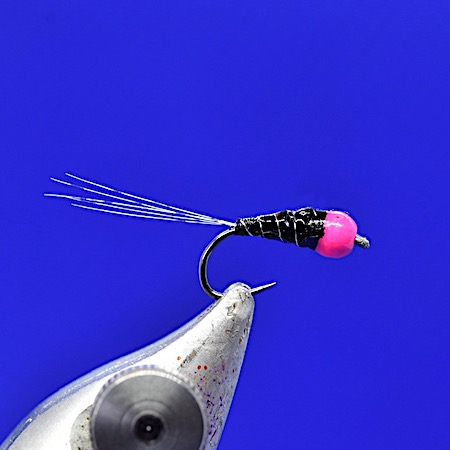
Pattern:
- Hook – size 14 HENDS BL 354
- Bead – 3mm pink tungsten bead
- Thread – Black 8/0
- Tail – Coq de León fibers
- Body – Black thread or floss
- Rib – Silver wire
- UV Resin coating
Olive Perdigon Nymph
Next up is the Olive Perdigon which is a versatile fly that works well in various water conditions, particularly in rivers with olive-coloured mayflies and caddisflies. Its natural olive hue makes it a reliable pattern for both trout and grayling, especially when fish are feeding on smaller nymphs in the early stages of the hatch.
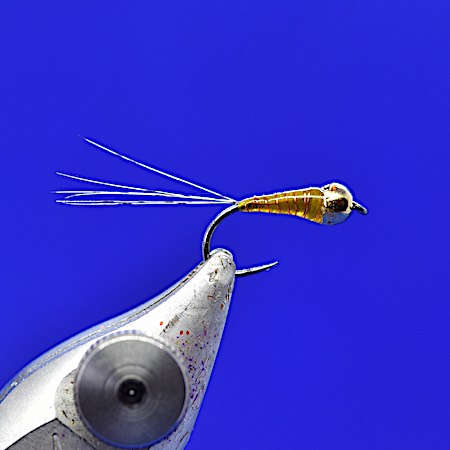
Pattern:
- Hook – size 16 HENDS BL 354
- Bead – 2.5mm gold tungsten bead
- Thread – Olive 8/0
- Tail – Coq de León fibers
- Body – Olive thread
- Rib – fine copper wire
- UV Resin coating
Fish the olive version in clear, moderately fast streams where fish are likely feeding on small mayflies. Drift it close to the bottom using a tight-line or Euro-nymphing technique. The quick sink rate ensures that the fly gets down fast, making it perfect for pocket water and riffles.
Orange Collar Peacock Quill Perdigon
When the river is clearing after a spate, fishing a nymph with a fluorescent orange hot spot often is a good a good choice. Especially when the river has been in flood for a while.
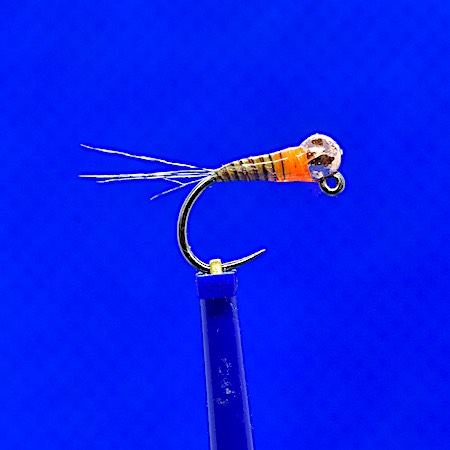
Pattern:
- Hook – size 14 HENDS BL124
- Bead – 3mm copper tungsten bead
- Thread – 8/0 Fluorescent Orange
- Tail – Coq de León fibers
- Body – Stripped Peacock Quill
- Collar – 8/0 Fluorescent Orange thread
- UV Resin coating
Brown Perdigon Nymph
The Brown Perdigon is an all-around great imitation of various aquatic insects, from caddis larvae to stonefly nymphs. Its earthy tones make it a great choice for clear water and sunny days when fish are feeding naturally in deeper water.
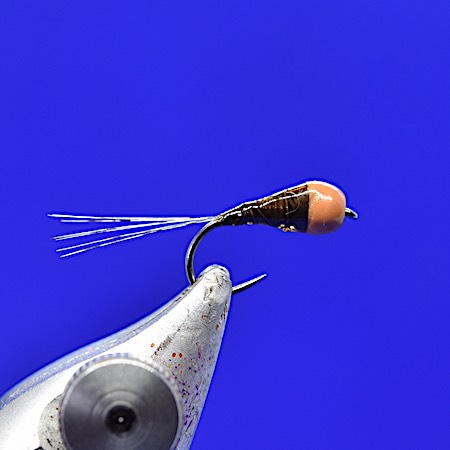
Pattern:
- Hook – size 14 HENDS BL 354
- Bead – 3mm brown tungsten bead
- Thread – Brown 8/0
- Tail – Coq de León fibers
- Body – Brown thread
- Rib – peacock Quill
- UV Resin coating
Fish this pattern in clear rivers or streams with a natural, earthy bottom. The brown body mimics a variety of nymphs that trout and grayling naturally feed on throughout the day. Use it with a lighter-coloured Perdigon to give the fish a choice, especially in clear water.
The Purple & Silver Perdigon Nymph
Purple nymphs stand out as a highly effective pattern when trout and grayling become selective or when fishing in bright, sunny conditions. The colour purple is often an overlooked but effective colour for nymph patterns, as it can be seen in a wide range of light conditions.

Tying pattern:
- Hook – size 16 HENDS BL354
- Bead – 2mm silver tungsten bead
- Thread – Purple 8/0
- Tail – Coq de León fibers
- Body – Purple thread
- UV Resin coating
This purple & silver nymph works best in sunny weather, as the combination of silver bead and purple body catches the light effectively, drawing attention to fish feeding in deeper pockets. It can also be a great choice in fast riffles where the bright bead and reflective body make it easy for fish to spot in turbulent water.
Techniques for fishing the Perdigon Nymphs
Now that we’ve covered the top Perdigon patterns for trout and grayling, let’s discuss the best approaches for fishing these deadly nymphs.
Tight Line Nymphing Technique:
Perdigon nymphs are tailor-made for tight line nymphing techniques (Euro Nymphing, French Leader, Czech nymphing). This method uses a long leader and a sensitive rod to keep the angler directly in contact with the fly. Because of their weight and slim profile, Perdigon nymphs cut through water quickly, making it easier to maintain a natural drift near the riverbed.
Usually, it’s best to fish the nymphs in streamy runs, riffles, and pool heads, because water turbulence brings the nymph to life…
making them irresistible.
Basics of how to nymph on a tight line:
- Use a long nymphing rod (10 –11 ft) for better line control.
- Opt for a thin leader (around 3–4lb) to reduce drag.
- Cast upstream and across the current and track the fly as it drifts downstream.
- Keep a tight connection with the fly, allowing you to feel even subtle takes.
- Strike quickly at any sign of a pause or tug.
For fast deep water consider using a double-Perdigon nymph rig. Pairing a heavier nymph with a smaller, more natural nymph can be highly effective, giving fish two options and increasing your chances of success.
Indicator Nymphing
While Euro-nymphing is the go-to for many Perdigon anglers, traditional indicator nymphing can also be highly effective. Perdigons fish well under a strike indicator, especially in deeper water or slower pools.
Basics of how to fish Perdigons with an indicator:
- Attach a small strike indicator or large dry fly several feet above the nymph.
- Cast upstream and mend the line to reduce drag.
- Watch the indicator closely for any unnatural movements, which signal a bite.
- Use a high-sticking technique in faster water to keep the fly in the strike zone longer.
Conclusion
Perdigon nymphs have proven to be highly effective for both trout and grayling due to their sleek design and rapid sink rates. By using the patterns mentioned above you’ll be well-equipped for a variety of fishing conditions.
The key to success with these nymphs lies not only in the patterns but in the techniques used to fish them. Whether you prefer Euro-nymphing, indicator nymphing, or a double-nymph setup, incorporating these highly effective nymphs into your fly box will increase your catch rate. So, next time you hit the water in pursuit of trout or grayling, make sure you have a selection of these Perdigon Nymphs ready to go.

Excellent advice as ever. May cross-over techniques to consider too! Thank you Andrew.
Great to hear you enjoyed it. Tight lines, Andrew
Excellent advice and well detailed. Thank you
Hi Phil,
Great to hear you enjoyed it.
Tight lines, Andrew
I am tying these up in various colours and different style hooks, Shrimp style hooks, straight eyed hooks and jig hooks.
Will try them on the Dee on my next outing . If no Salmon show then an hour or so of Nymphing may entice a Grayling or two.
Hi Colin,
Good luck on your next trip. Also it would be great to know how you get on with the nymphs.
Tight lines, Andre